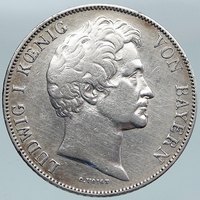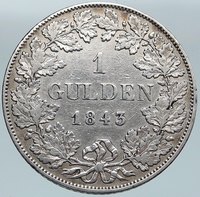Germany - German States. Bavaria
Ludwig I - King: 13 October 1825 - 20 March 1848
1843 Silver Gulden 29mm (10.46 grams) 0.900 Silver (0.3067 oz. ASW)
Reference: KM# 788, AKS# 78 | Engraver: Carl Friedrich Voigt
LUDWIG I KŒNIG VON BAYERN C.VOIGT, Ludwig I facing right.
1 GULDEN, Laurels around outer with Ribbon at bottom.
You are bidding on the exact item pictured, provided with a Certificate of Authenticity and Lifetime Guarantee of Authenticity.
 The Kingdom of Bavaria (German: Königreich Bayern; Austro-Bavarian: Kinereich Bayern) was a German state that succeeded the former Electorate of Bavaria in 1805 and continued to exist until 1918. The Bavarian Elector Maximilian IV Joseph of the House of Wittelsbach became the first King of Bavaria in 1805 as Maximilian I Joseph. The crown would go on being held by the Wittelsbachs until the kingdom came to an end in 1918. Most of Bavaria's present-day borders were established after 1814 with the Treaty of Paris, in which Bavaria ceded Tyrol and Vorarlberg to the Austrian Empire while receiving Aschaffenburg and Würzburg. With the unification of Germany into the German Empire in 1871, the kingdom became a federal state of the new Empire and was second in size, power, and wealth only to the leading state, the Kingdom of Prussia. In 1918, Bavaria became a republic, and the kingdom was thus succeeded by the current Free State of Bavaria. The Kingdom of Bavaria (German: Königreich Bayern; Austro-Bavarian: Kinereich Bayern) was a German state that succeeded the former Electorate of Bavaria in 1805 and continued to exist until 1918. The Bavarian Elector Maximilian IV Joseph of the House of Wittelsbach became the first King of Bavaria in 1805 as Maximilian I Joseph. The crown would go on being held by the Wittelsbachs until the kingdom came to an end in 1918. Most of Bavaria's present-day borders were established after 1814 with the Treaty of Paris, in which Bavaria ceded Tyrol and Vorarlberg to the Austrian Empire while receiving Aschaffenburg and Würzburg. With the unification of Germany into the German Empire in 1871, the kingdom became a federal state of the new Empire and was second in size, power, and wealth only to the leading state, the Kingdom of Prussia. In 1918, Bavaria became a republic, and the kingdom was thus succeeded by the current Free State of Bavaria.
 Ludwig I or Louis I (German: Ludwig I.; 25 August 1786 - 29 February 1868) was king of Bavaria from 1825 until the 1848 revolutions in the German states. Ludwig I or Louis I (German: Ludwig I.; 25 August 1786 - 29 February 1868) was king of Bavaria from 1825 until the 1848 revolutions in the German states.
Crown princeBorn in the Hôtel des Deux-Ponts in Strasbourg, he was the son of Count Palatine Maximilian Joseph of Zweibrücken (later Maximilian I Joseph of Bavaria) by his first wife Princess Augusta Wilhelmine of Hesse-Darmstadt. At the time of his birth, his father was an officer in the French army stationed at Strasbourg. He was the godson and namesake of Louis XVI of France. On 1 April 1795 his father succeeded Ludwig's uncle, Charles II, as duke of Zweibrücken, and on 16 February 1799 became Elector of Bavaria and Count Palatine of the Rhine, the Arch-Steward of the Empire, and Duke of Berg on the extinction of the Sulzbach line with the death of the elector Charles Theodore. His father assumed the title of King of Bavaria on 1 January 1806. Starting in 1803 Ludwig studied in Landshut where he was taught by Johann Michael Sailer and in Göttingen. On 12 October 1810 he married Therese of Saxe-Hildburghausen (1792-1854), the daughter of Frederick, Duke of Saxe-Hildburghausen. The wedding was the occasion of the first-ever Oktoberfest. Ludwig strongly rejected the alliance of his father with Napoleon I of France but in spite of his anti-French politics the crown prince had to join the emperor's wars with allied Bavarian troops in 1806. As commander of the 1st Bavarian Division in VII Corps, he served under Marshal François Joseph Lefebvre in 1809.[1] He led his division in action at the Battle of Abensberg on 20 April. With the Treaty of Ried of 8 October 1813 Bavaria left the Confederation of the Rhine and agreed to join the Sixth Coalition against Napoleon in exchange for a guarantee of her continued sovereign and independent status. On 14 October, Bavaria made a formal declaration of war against Napoleonic France. The treaty was passionately backed by Crown Prince Ludwig and by Marshal von Wrede. Already at the 1815 Congress of Vienna, Ludwig advocated a German national policy. Until 1816 the crown prince served as governor-general of the Duchy of Salzburg, which cession to Austria he strongly opposed. His second son Otto, the later King of Greece, was born there. Between 1816 and 1825, he spent his years in Würzburg. He also made numerous trips to Italy and stayed often in the Villa Malta in Rome, which he later also bought (1827). Ludwig supported generously as a Philhellene the Greek War of Independence, in which he in the war of 1821 provided a loan of 1.5 million florins from his private funds. In 1817 Ludwig was also involved in the fall of Prime Minister Count Max Josef von Montgelas whose policies he had opposed. He succeeded his father on the throne in 1825. ReignLudwig's rule was strongly affected by his enthusiasm for the arts and women and by his overreaching royal assertiveness. An enthusiast for the German Middle Ages, Ludwig ordered the re-erection of several monasteries in Bavaria which had been closed during the German Mediatisation. He reorganized the administrative regions of Bavaria in 1837 and re-introduced the old names Upper Bavaria, Lower Bavaria, Franconia, Swabia, Upper Palatinate and Palatinate. He changed his royal titles to Ludwig, King of Bavaria, Duke of Franconia, Duke in Swabia and Count Palatine of the Rhine. His successors kept these titles. Ludwig's plan to reunite the eastern part of the Palatinate with Bavaria could not be realized. The Electoral Palatinate, a former dominion of the Wittelsbach, had disappeared under Napoleon when France first annexed the left bank of the Rhine, including about half of the Palatinate, and then gave what remained on the right bank including, Mannheim and Heidelberg, to Baden during the German Mediatization of 1803. In 1815, Baden's possession of Manheim and Heidelberg was confirmed and only the left bank territories were given back to Bavaria. Ludwig founded the city of Ludwigshafen there as a Bavarian rival to Mannheim. Ludwig moved the Ludwig-Maximilians-Universität from Landshut to Munich in 1826. The king also encouraged Bavaria's industrialization. He initiated the Ludwig Canal between the rivers Main and the Danube. In 1835 the first German railway was constructed in his domain, between the cities of Fürth and Nuremberg. Bavaria joined the Zollverein in 1834. As Ludwig had supported the Greek fight of independence his second son Otto was elected king of Greece in 1832. Otto's government was initially run by a three-man regency council made up of Bavarian court officials. After the July Revolution of 1830 in France, Ludwig's previous liberal policy became more and more repressive. The Hambacher Fest in 1832 revealed the discontent of the population caused by high taxes and censorship. In connection with the unrest of May 1832, some 142 political trials were initiated. The seven death sentences that were pronounced were commuted to long-term imprisonment by the king. About 1,000 political trials were to take place during Ludwig's reign. The strict censorship, which he had reinstated after having abolished it in 1825, was opposed by large sectors of the population. In 1837 the Ultramontanes backed by the Roman Catholic Church gained control of the Bavarian parliament and began a campaign of changes to the constitution, such as removing civil rights that had earlier been granted to Protestants, as well as enforcing political censorship. On 14 August 1838, the King issued an order for all members of the military to kneel in the presence of the Blessed Sacrament at Corpus Christi processions and church services. This policy, which had been in place when Bavaria was still almost purely Catholic in the period before 1803, had been discontinued the inclusion of large Protestant areas. Catholic disturbances during the funeral of the Protestant Queen Caroline of Baden in 1841 caused a scandal. This treatment of his beloved stepmother permanently softened the attitude of Caroline's stepson Ludwig I, who up until that time had been a strong opponent of Protestantism in spite of his marriage to the Protestant princess Therese of Saxe-Hildburghausen. The Ultramontanes' regime only ended due to their demands against the naturalization of Ludwig I's Irish-born mistress Eliza Gilbert (better known by her stage name Lola Montez). Ludwig resented this move and the Ultramontanes under Karl von Abel were pushed out. Already in 1844, Ludwig was confronted with the Beer riots in Bavaria. During the revolutions of 1848 the king faced increasing protests and demonstrations by the students and the middle classes. The King had ordered to close the university in February and on 4 March a large crowd assaulted the Armory to storm the Munich Residenz. Ludwig's brother Prince Karl managed to appease the protesters, but now the royal family and the Cabinet turned against Ludwig. He had to sign the so-called "March Proclamation" with substantial concessions. On 16 March 1848 it was followed by renewed unrest because Lola Montez had returned to Munich after a short exile. Ludwig had to let her be searched by the police on 17 March, which was the worst humiliation for him.[clarification needed] Not willing to rule as a constitutional monarch, Ludwig abdicated on 20 March 1848 in favour of his eldest son, Maximilian. Ludwig lived for another twenty years after his abdication and remained influential, especially as he continued several of his cultural projects. Most of his time in Munich his residence was the neo gothic Wittelsbacher Palais, once built for his successor and unloved by Ludwig. He died at Nice in 1868, and was buried in St. Boniface's Abbey, Munich he had ordered to be built.
  Germany, officially the Federal Republic of Germany is a federal parliamentary republic in western-central Europe. It includes 16 constituent states and covers an area of 357,021 square kilometres (137,847 sq mi) with a largely temperate seasonal climate. Its capital and largest city is Berlin. With 81 million inhabitants, Germany is the most populous member state in the European Union. After the United States, it is the second most popular migration destination in the world. Germany, officially the Federal Republic of Germany is a federal parliamentary republic in western-central Europe. It includes 16 constituent states and covers an area of 357,021 square kilometres (137,847 sq mi) with a largely temperate seasonal climate. Its capital and largest city is Berlin. With 81 million inhabitants, Germany is the most populous member state in the European Union. After the United States, it is the second most popular migration destination in the world.
Various Germanic tribes have occupied northern Germany since classical antiquity. A region named Germania was documented before 100 CE. During the Migration Period the Germanic tribes expanded southward. Beginning in the 10th century, German territories formed a central part of the Holy Roman Empire. During the 16th century, northern German regions became the centre of the Protestant Reformation. The rise of Pan-Germanism inside the German Confederation resulted in the unification of most of the German states in 1871 into the Prussian-dominated German Empire. After World War I and the German Revolution of 1918-1919, the Empire was replaced by the parliamentary Weimar Republic. The establishment of the Third Reich in 1933 led to World War II and the Holocaust. After 1945, Germany split into two states, East Germany and West Germany. In 1990, the country was reunified.  In the 21st century, Germany is a great power and has the world's fourth-largest economy by nominal GDP, as well as the fifth-largest by PPP. As a global leader in several industrial and technological sectors, it is both the world's third-largest exporter and importer of goods. Germany is a developed country with a very high standard of living sustained by a skilled and productive society. It upholds a social security and universal health care system, environmental protection and a tuition free university education. In the 21st century, Germany is a great power and has the world's fourth-largest economy by nominal GDP, as well as the fifth-largest by PPP. As a global leader in several industrial and technological sectors, it is both the world's third-largest exporter and importer of goods. Germany is a developed country with a very high standard of living sustained by a skilled and productive society. It upholds a social security and universal health care system, environmental protection and a tuition free university education.
Germany was a founding member of the European Union in 1993. It is part of the Schengen Area, and became a co-founder of the Eurozone in 1999. Germany is a member of the United Nations, NATO, the G8, the G20, and the OECD. The national military expenditure is the 9th highest in the world. Known for its rich cultural history, Germany has been continuously the home of influential artists, philosophers, musicians, sportsmen, entrepreneurs, scientists and inventors.
| 

 The Kingdom of Bavaria (German: Königreich Bayern; Austro-Bavarian: Kinereich Bayern) was a German state that succeeded the former Electorate of Bavaria in 1805 and continued to exist until 1918. The Bavarian Elector Maximilian IV Joseph of the House of Wittelsbach became the first King of Bavaria in 1805 as Maximilian I Joseph. The crown would go on being held by the Wittelsbachs until the kingdom came to an end in 1918. Most of Bavaria's present-day borders were established after 1814 with the Treaty of Paris, in which Bavaria ceded Tyrol and Vorarlberg to the Austrian Empire while receiving Aschaffenburg and Würzburg. With the unification of Germany into the German Empire in 1871, the kingdom became a federal state of the new Empire and was second in size, power, and wealth only to the leading state, the Kingdom of Prussia. In 1918, Bavaria became a republic, and the kingdom was thus succeeded by the current Free State of Bavaria.
The Kingdom of Bavaria (German: Königreich Bayern; Austro-Bavarian: Kinereich Bayern) was a German state that succeeded the former Electorate of Bavaria in 1805 and continued to exist until 1918. The Bavarian Elector Maximilian IV Joseph of the House of Wittelsbach became the first King of Bavaria in 1805 as Maximilian I Joseph. The crown would go on being held by the Wittelsbachs until the kingdom came to an end in 1918. Most of Bavaria's present-day borders were established after 1814 with the Treaty of Paris, in which Bavaria ceded Tyrol and Vorarlberg to the Austrian Empire while receiving Aschaffenburg and Würzburg. With the unification of Germany into the German Empire in 1871, the kingdom became a federal state of the new Empire and was second in size, power, and wealth only to the leading state, the Kingdom of Prussia. In 1918, Bavaria became a republic, and the kingdom was thus succeeded by the current Free State of Bavaria.  Ludwig I or Louis I (German: Ludwig I.; 25 August 1786 - 29 February 1868) was king of Bavaria from 1825 until the 1848 revolutions in the German states.
Ludwig I or Louis I (German: Ludwig I.; 25 August 1786 - 29 February 1868) was king of Bavaria from 1825 until the 1848 revolutions in the German states. 
 Germany, officially the Federal Republic of Germany is a federal parliamentary republic in western-central Europe. It includes 16 constituent states and covers an area of 357,021 square kilometres (137,847 sq mi) with a largely temperate seasonal climate. Its capital and largest city is Berlin. With 81 million inhabitants, Germany is the most populous member state in the European Union. After the United States, it is the second most popular migration destination in the world.
Germany, officially the Federal Republic of Germany is a federal parliamentary republic in western-central Europe. It includes 16 constituent states and covers an area of 357,021 square kilometres (137,847 sq mi) with a largely temperate seasonal climate. Its capital and largest city is Berlin. With 81 million inhabitants, Germany is the most populous member state in the European Union. After the United States, it is the second most popular migration destination in the world. In the 21st century, Germany is a great power and has the world's fourth-largest economy by nominal GDP, as well as the fifth-largest by PPP. As a global leader in several industrial and technological sectors, it is both the world's third-largest exporter and importer of goods. Germany is a developed country with a very high standard of living sustained by a skilled and productive society. It upholds a social security and universal health care system, environmental protection and a tuition free university education.
In the 21st century, Germany is a great power and has the world's fourth-largest economy by nominal GDP, as well as the fifth-largest by PPP. As a global leader in several industrial and technological sectors, it is both the world's third-largest exporter and importer of goods. Germany is a developed country with a very high standard of living sustained by a skilled and productive society. It upholds a social security and universal health care system, environmental protection and a tuition free university education.
